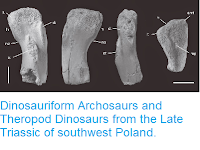Archosauromorphs, defined as everything more closely related to Dinosaurs and Crocodiles than to Lepidosaurs (Lizards, Snakes and Sphenodon, flourished in the aftermath of the End Permian Extinction, becoming the dominant Vertebrates in most terrestrial ecosystems. They have suffered heavily in each of the subsequent mass extinction events, particularly the End Triassic and End Cretaceous, but each time recovered, with over 10 000 species still alive today (Mostly Birds). These animals have an excellent fossil record from the Middle Triassic across much of Europe, though to date this is very limited in the Iberian Peninsula, with only a single described species, the Tanystropheid Cosesaurus aviceps from the Montral-Alcover Basin.
In a paper described in the journal Palaeontologia Electronica on 5 December 2017, Martín Ezcurra of the Sección Paleontología de Vertebrados at the Museo Argentino de Ciencias Naturales, Josep Fortuny at the Institut Català de Paleontologia at the Universitat Autònoma de Barcelona, and the Centre de Recherches en Paléobiodiversité et Paléoenvironnements at the Muséum National d'Histoire Naturelle, Eudald Mujal of the Departament de Geologia at the Universitat Autònoma de Barcelona, and Arnau Bolet, also of the Institut Català de Paleontologia at the Universitat Autònoma de Barcelona, describe new Archosauromorph remains from the Early-Middle Triassic La Mora Site in the Catalan Basin of northeastern Spain.
The remains comprise three partial tooth crowns, lacking their tips, and being blade shaped and curved with numerous serrations. These are interpreted as having come from a member of the Crocopoda, an advanced group of Archosauromorphs that includes both the Crocodiles and Dinosaurs, as well as other derived Archosauromorphs, such as Rynchosaurs and Phytosaurs.
See also...
The remains comprise three partial tooth crowns, lacking their tips, and being blade shaped and curved with numerous serrations. These are interpreted as having come from a member of the Crocopoda, an advanced group of Archosauromorphs that includes both the Crocodiles and Dinosaurs, as well as other derived Archosauromorphs, such as Rynchosaurs and Phytosaurs.
Isolated Crocopodan Archosauromorph teeth from the Early−Middle Triassic of Catalonia. (1) First specimen in apical (top) and lingual (bottom) views and close up of distal denticles; (2) second specimen in labial view and close up of distal denticles; (3) third specimen in side view and close up of distal denticles. Abbreviations: cr, crown; ro, root. Scale bars equal 2 mm in (1), 5 mm in (2, 3), 0.2 mm in close up of (1), 0.5 mm in close up of (2), and 1 mm in close ups of (3). Ezcurra et al. (2017).
See also...
Follow Sciency Thoughts on Facebook.







